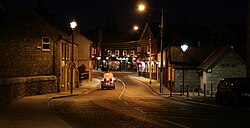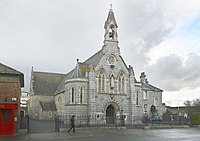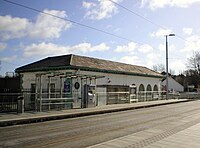Difference between revisions of "Dundrum, County Dublin"
(Created page with "{{Infobox town |name=Dundrum |irish=Dún Droma |county=Dublin |picture=DundrumVillage0586c.jpg |picture caption=Dundrum from Ballinteer Road |os grid ref=O171280 |latitude=53....") |
(No difference)
|
Latest revision as of 21:05, 23 February 2021
| Dundrum Irish: Dún Droma | |
| County Dublin | |
|---|---|
 Dundrum from Ballinteer Road | |
| Location | |
| Grid reference: | O171280 |
| Location: | 53°17’23"N, 6°14’39"W |
| Data | |
| Postcode: | D14 / D16 |
| Dialling code: | 01 |
| Local Government | |
| Council: | Dún Laoghaire–Rathdown |
Dundrum is a town in County Dublin which has been absorbed into the urban growth of the county's great city so as to become an outer suburb of Dublin.
The name of the town is from the Irish Dún Droma, meaning 'ridge fort'.
In Dundrum is the largest shopping centre in the country.
History
One of the earliest mentions of the area concerns the location of the original St Nahi's Church in the 8th century on which site today's 18th-century church currently stands. The ancient name for Dundrum is "Taney" which derives from Tigh Naithi meaning the house or place of |Nath Í (Nath Í of Cúl Fothirbe).
Modern archaeological excavations near the church have revealed three enclosures associated with the church, the earliest dating from the 6th century, and one of the finds included an almost complete Flemish Redware jug from the 13th century.
The first reference to the name 'Taney' occurs in the Charter of St Laurence O'Toole to Christchurch in 1178 as "half of Rathnahi" and in the following year in a Papal bull of Pope Alexander III to the same archbishop as "Medietatem de Tignai". Variations of the spelling continued until the mid-16th century.
After the Normans had arrived in 1169, a castle was built in Dundrum, possibly around the 13th century, as part of this series of outer fortifications built around Dublin. Later in 1590, a newer castle was built by Richard Fitzwilliam as part of a strategic line of castles within the Pale. The original village clustered around Dundrum Castle and was a rural defensive outpost against assaults and raids from Irish tribes and families such as the O'Tooles and the O'Byrnes. In 1619, a relation, William FitzWilliam, 3rd Viscount FitzWilliam was granted the castle in recognition of his courage while defending against these assaults but was driven out in 1642. He returned by 1646 but left again, never to return, in 1653. His family held onto the Fitzwilliam seat until 1790. The castle was never reoccupied and exists today as ruins overlooking the Dundrum bypass and the shopping centre. Excavations in 1989 recovered green glazed pottery known as "Leinster Ware", shells from oysters and cockles, animal bones, and shards of pottery from Saintongue in France probably used for storing wine.
The arrival of Richard Fitzwilliam and the building of the castle established commercial activity in the region. The village was home to "The Manor Mill" where corn was ground into flour. An overflow waterfall was also used by a paper mill and an ironworks.
In 1813, the original Roman Catholic church on Main Street was built. It was replaced by a larger building in 1878 and marked when Dundrum was constituted a separate parish from the area previously covered by Booterstown. A large extension was built in 1956. The church is built in a Gothic style from Dublin granite with Portland and Bath stone used for the surrounds of windows and doors.
In 1818, Christ Church on Taney Road was opened as a replacement for a smaller church that stood on the same site. Selling pew sites raised funding for the new building, and the sale of 18 pews on the ground and 8 on the gallery raised nearly £400. The architect for the new church was William Farrell.
In the summer of 1846, Thomas Carlyle travelled from Scotland to Dundrum to spend time with his close friend Charles Gavin Duffy, one of the co-founders of Young Ireland. Joining Duffy were "most of the writers and orators on whom their contemporaries bestowed the sobriquet of Young Ireland" (C.G. Duffy, Conversations with Carlyle, 1892, NY: Schribner's Son, p. 22).
The village expanded greatly after the arrival of the Dublin and South Eastern Railway in 1854. By 1876, the Manor Mill became a laundry and was the largest employer of female labour in the region, The laundry hooter was a regular sound in its day, and would sound at 7.50am for thirty seconds, then at 8am to start work, and also at 13.50, 14.00, and finally at 16.50 and 17.00.
In 1881, a local builder, John Richardson, erected 26 cottages known as the Pembroke Cottages. The Manor Mill Laundry bought six of these cottages for its workers.
In 1893, a Dublin solicitor named Trevor Overend purchased an 18th-century farmhouse. Today, this building is named Airfield House and is open to the public.
The Dun Emer Press was founded at Dundrum by Elizabeth Yeats, assisted by her brother William Butler Yeats, in 1903.
In 1914, a Carnegie Library was opened by the then Lord Chancellor. Originally, the library was used as an entertainment facility for the community and the upper floor was equipped with a stage and even a kitchen. The building was also used as a school until the 1950s.
Development
In 1971, Dundrum was one of the earliest places in Ireland to open a purpose-built shopping centre (the first being in Stillorgan). A much bigger shopping centre opened just south of Dundrum on 3 March 2005. Known as Dundrum Town Centre it contains within the complex one of the largest cinemas in Ireland, opened in early October 2005. The plans for the old shopping centre includes space for hotels, apartments and more retail outlets. However this has been postponed and the older retail units have been leased to new tenants such as Lidl, Classic Furniture, Mulvey's of Dundrum. Recently the old Dundrum Shopping Centre has been rebranded Dundrum Village Centre.
The College of Further Education in Dundrum is the local community Education and Training Board college.
Sport
- Athletics: Dundrum Athletic
- Football: Dundrum Athletic F.C.
- Gaelic Athletics: Naomh Olaf GAA


